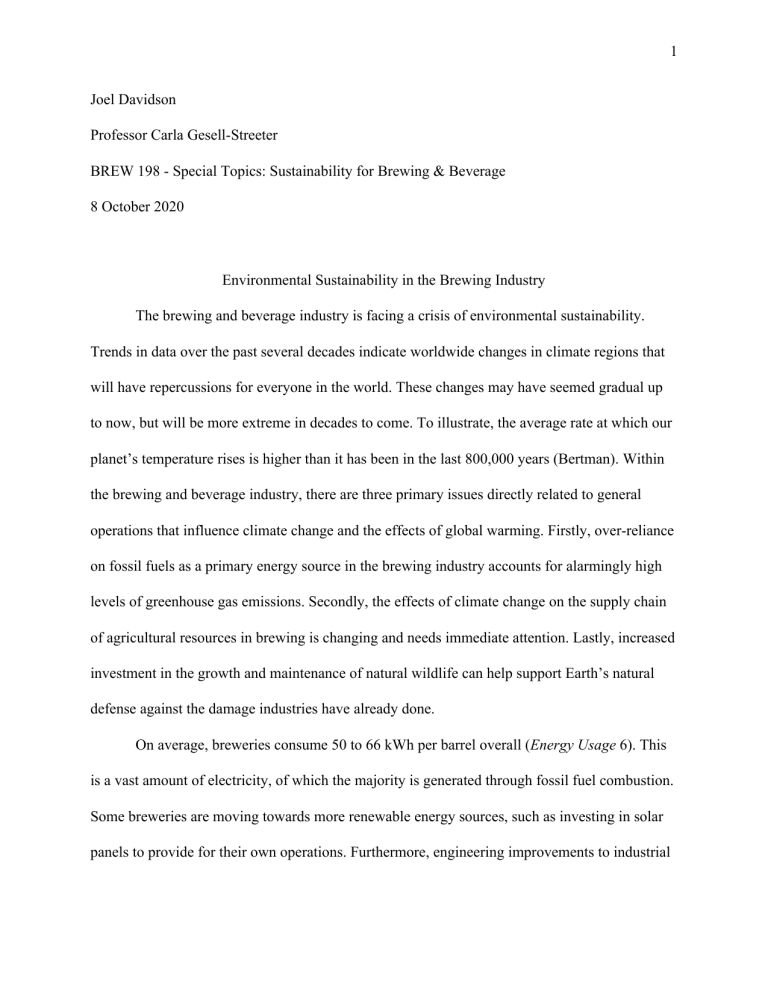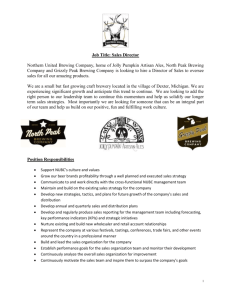
1 Joel Davidson Professor Carla Gesell-Streeter BREW 198 - Special Topics: Sustainability for Brewing & Beverage 8 October 2020 Environmental Sustainability in the Brewing Industry The brewing and beverage industry is facing a crisis of environmental sustainability. Trends in data over the past several decades indicate worldwide changes in climate regions that will have repercussions for everyone in the world. These changes may have seemed gradual up to now, but will be more extreme in decades to come. To illustrate, the average rate at which our planet’s temperature rises is higher than it has been in the last 800,000 years (Bertman). Within the brewing and beverage industry, there are three primary issues directly related to general operations that influence climate change and the effects of global warming. Firstly, over-reliance on fossil fuels as a primary energy source in the brewing industry accounts for alarmingly high levels of greenhouse gas emissions. Secondly, the effects of climate change on the supply chain of agricultural resources in brewing is changing and needs immediate attention. Lastly, increased investment in the growth and maintenance of natural wildlife can help support Earth’s natural defense against the damage industries have already done. On average, breweries consume 50 to 66 kWh per barrel overall (Energy Usage 6). This is a vast amount of electricity, of which the majority is generated through fossil fuel combustion. Some breweries are moving towards more renewable energy sources, such as investing in solar panels to provide for their own operations. Furthermore, engineering improvements to industrial 2 brewing equipment continue to improve efficiency in the usage of electricity, fuel, CO2, and water as technology advances. Not enough breweries are investing in these changes presently. The initial expense of installing a solar panel grid, or of purchasing top-of-the-line equipment may not be considered financially viable for many startup brewery operations. In the long run, however, these investments are likely to save money for the business of brewing, and to be more environmentally sustainable. All in all, reducing primary-reliance on fossil fuels is the most important step for reducing the carbon footprint of the brewing industry as a whole. Climate change has already influenced a Northward shift of agricultural regions in where the two most important brewing crops—barley and hops—can grow in the United States. The growing seasons for barley and hops in the Pacific Northwest are now longer on average, with higher temperatures, and more droughts. In the next few decades, the prime territory for these crops is likely to migrate to Canada. The best way the brewing industry can adapt is by focusing more effort in breeding new varieties of hops and barley that will be more resilient to a dry, hot climate (Bertman). This will be required to meet a steadily growing demand for beer if the current trend in climate change continues on its path. As stated prior, climate change has been influenced by a vast amount of greenhouse gas emissions (primarily CO2). It is also influenced by the shrinking of our planet’s natural way of balancing out its atmosphere—through forests and other plant life. The Amazon rainforest removes approximately 2 billion tons of CO2 annually (Kaiser). Maintaining this region, and other forested areas, is pivotal to our continued existence. Rural development in the form of farmhouse brewing has found a foothold in American brewery culture. These types of breweries are performing a unique function—one that is more difficult for breweries in urban or suburban 3 areas. Not only do farmhouse breweries provide a quaint destination for guests to enjoy, but they also integrate their operations among their pastoral surroundings, cultivating a wide variety of plant life, which process greenhouse gases out of the atmosphere. Farmhouse breweries actively work towards cleaning up the carbon footprint they, and other breweries create. As current and future operators within the brewing industry, we share responsibility for current non-viable usage of natural resources. We have data that projects what the future of the industry will look like, and the bottom line is that two of beer’s essential ingredients are in jeopardy. We are aware of measures we can take to sustain our livelihood for the long term. This will require being better stewards of the only place we can presently brew and drink our beer—Planet Earth. We need to reduce the carbon footprint of brewing operations, develop more viable crops for brewing in an inevitably-changing climate, and foster growth of plant life in our nearby vicinity as much as possible to lift our carbon footprint. Operators of breweries of every size from nano to macro must be concerned with these issues, and participate in innovative, environmentally sustainable procedures as much as possible. There is much work to be done. 4 Works Cited Bertman, S. “How Will Climate Change Affect Brewing?” Craft Brewer’s Conference. Brewer’s Association. 20 May 2020. CBC Online Seminar. Brewer’s Association. Energy Usage, GHG Reduction, Efficiency and Load Management Manual. Brewer’s Association. 2018. Kaiser, Anna Jean. “AP Explains: Role of the Amazon in Global Climate Change.” Associated Press. 27 Aug. 2019. https://apnews.com/article/384fdb5ee7654667b53ddb49efce8023. Accessed 8 Oct. 2020.


